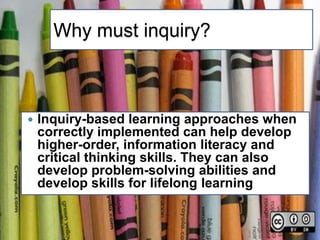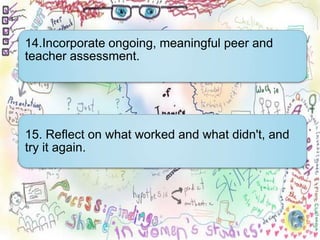Inquiry..fix
- 1. INQUIRY- BASED LEARNING By: Yuliana Dewi Anggraeni
- 2. What is inquiry? Inquiry-based learning is a constructivist approach, in which students have ownership of their learning. It starts with exploration and questioning and leads to investigation into a worthy question, issue, problem or idea. It involves asking questions, gathering and analyzing information, generating solutions, making decisions, justifying conclusions and taking action
- 3. Why must inquiry? Inquiry-based learning approaches when correctly implemented can help develop higher-order, information literacy and critical thinking skills. They can also develop problem-solving abilities and develop skills for lifelong learning
- 4. Teacher's Role The teacher's role in inquiry-based learning is one of 'Guide on the side' rather than 'Sage on the stage". The teacher scaffolds learning for students, gradually removing the scaffolding as students develop their skills. With young children or students new to inquiry it is usually necessary to use a form of guided inquiry.
- 5. Characteristics of inquiry- learning Inquiry learning emphasizes constructivist ideas of learning. Knowledge is built in a step-wise fashion. Learning proceeds best in group situations. The teacher does not begin with a statement, but with a question. Posing teaching questions for students to solve is a more effective method of instruction in many areas. This allows the students to search for information and learn on their own with the teacher's guidance. The topic, problem to be studied, and methods used to answer this problem are determined by the student and not the. The above comments represent a classroom that is fully committed to inquiry, to the greatest extent possible. However, it is not necessary to take an all-or-nothing approach to inquiry- based methods. Picture :http://farm7.staticflickr.com/6021/6005580301_cee0e61f34_z.jpg
- 6. APPLICATION OF INQUIRY - LEARNING Inquiry learning can be applied to all disciplines. Individuals need many perspectives for viewing the world. Such views could include artistic, scientific, historic, economic, and other perspectives. While disciplines should interrelate, inquiry learning includes the application of certain specific "ground rules" that insure the integrity of the various disciplines and their world views.
- 7. Key Components of the Inquiry Process 1. Activating Prior Knowledge • By bringing the students' own background and experiences to the learning table, students will find ways to connect to the topic and will have activated some basis for creating meaning with the text they are reading. The personal connection to learning increases a student's motivation to explore, read, and struggle with difficulties as they arise. 2. Providing Background Information • Provide source material because student need to know something about the topic to be able to perceive and formulate meaningful inquiries, such us :articles, go to museum exhibits, listen to audio recording, or videosbook- primary source material-web site-photography.
- 8. 3. Defining Outcomes for which students will be held accountable. • Inquiry: define problem question; find and gather data; analyze, compare, organize, and synthesize data; create a proposition; support proposition (facts, stats, examples, expert authority, logic and reasoning); propose solutions and action steps 4. Modeling Design Product Outcomes (technology, art); Providing Frameworks • Show students a PowerPoint presentation, a web site, a proposition- support framework, a museum exhibit, a choreographed dance performance, etc. Students need to see models of what it is they are being asked to do. They must have a supporting structure which provides a grounding for their creations, but doesn't limit their creativity.
- 9. 5.Establishing a general topic or inquiry • A broad problem question or topic provides students with a general focus for selecting more specific inquiries. 6. Student teams conduct background research and define focused problem questions within broader inquiry or topic • Without a knowledge base or some degree of familiarity with the topic, it will be difficult for students to develop relevant inquiries within the broad topic area. Students need to be provided with background material and/or guided to research their own background material. This base will enable them to begin to formulate a big picture understanding of the broad topic area, and then to select a specific inquiry interest which connects to the broader topic.
- 10. 7. Establish and communicate inquiry presentation framework. • a) state problem question • b) develop proposition which can be argued • c) provide background information d) support proposition with: facts, statistics, examples, expert authority, logic and reasoning • e) propose solutions and action ideas 8. Refer students back to expected outcomes and inquiry framework to create alignment between their presentations and intended outcomes. 9. Ask students a lot of questions to help them refine their thinking and guide their research.
- 11. 10. upport technology (PowerPoint, Web Site, Hyperstudio) and art design product creation. 11. Empower students to coach and train one another within their teams. 12.Provide a forum for student presentations which includes students, teachers, parents, and community members. 13. Provide vehicles for student participation in action projects which connect their learning to specific action.
- 12. 14.Incorporate ongoing, meaningful peer and teacher assessment. 15. Reflect on what worked and what didn't, and try it again.
- 13. Source http://farm4.staticflickr.com/3377/3272923191_d6b dde2255_m.jpg http://farm4.staticflickr.com/3377/3272923191_d6b dde2255_m.jpg Sharon Friesen and www.galileo.org/inquiry- what.html http://farm5.staticflickr.com/4026/4378920267_207 ea66090.jpg http://farm6.staticflickr.com/5293/5524124901_d61 802f78a_m.jpg
- 14. http://farm3.staticflickr.com/2189/2205908041_e42992b11 4_z.jpgzz=1 http://en.wikipedia.org/wiki/Inquiry-based_learning http://farm3.staticflickr.com/2730/4384998192_188062f05 5.jpg http://farm1.staticflickr.com/2074/99426001_bd34339939.j pg ttp://farm1.staticflickr.com/1114/666968_9f6e513300_z.jp gzz=1 http://farm1.staticflickr.com/1014/660558_77b3eba7d3_z.j pgzz=1 http://farm1.staticflickr.com/9146/84522_f6542a23a8_z.jp gzz=1 http://farm8.staticflickr.com/7161/6452967363_f272d3068 5_z.jpg http://education-2020.wikispaces.com/Inquiry- based+Learning http://farm4.staticflickr.com/3364/3272923341_85e5c9fd5
- 15. ~ The End~















